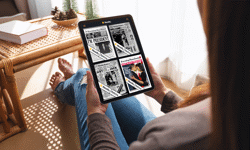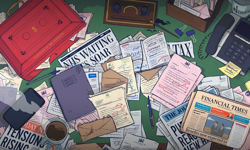Format vs content
"Keep in mind that, regardless of the technology ... and the way news will be delivered ... the name of the game for journalists will still be creating the content that drives the media. That means getting better at writing and editing ... and getting better at listening to what information consumers will buy and what audiences advertisers will pay to reach." (American Newspapers Association briefing paper.)
Broadsheet, tabloid, compact, Berliner, broadloid … who cares anyway? It’s not the format that will sell newspapers it’s the content. The stories, the pictures, the giveaways - even the advertising - will initially lure the readers and ultimately hook them if it’s good enough. The format, of course, plays its part, but for every person I see on the train reading a Berliner-shape Guardian or a compact Times I see another looking at their mobile phone or BlackBerry.
Ultimately, the vehicle for the content will continue to evolve. Of course, the newspaper is not dead, any more than it was sent to the grave when television came along. But newspaper publishers worldwide are continually looking at ways to safeguard the readership and the all-important advertising revenue that is under threat from all sides.
Efforts to persuade different parts of the industry to measure readership rather than sale have not proved very successful. However, with major players like the Guardian migrating more and more of their readership from paper to online this cannot be far away.
A comparison of sales v readership (see table below) throws up some surprising results. The top three in both lists – the Sun, Daily Mail and Daily Mirror – account for nearly two-thirds of total sale (63.9%) and slightly less readership (60.4%). That leaves the other seven titles slugging it out for just four out of every 10 readers.
The ‘quality’ (does that make the rest ‘inferior’?) sector accounts for just over 20% of both sale and readership. Put plainly, only one in five of the newspaper reading public looks at a grown-up newspaper. All these titles will, of course, crow about how influential, educated and disposed to throw their money around these small groups of readers are. And, while they may shuffle from one paper to another depending on the number of Sudokus or two-for-one lunches on offer, this group is still small.
The readership numbers have a big bite taken out of them by the Metro. The figures from the National Readership Survey include only the London version of Northcliffe’s free morning tabloid but, at 1.83m it still boasts a bigger readership than the Times (1.74m) and the Guardian and Independent combined (1.79m). Newspapers are still incredible value – I can buy 300 pages of newsprint for the price of a cup of coffee – but there’s no better value than free.
Our national newspaper industry is so entrenched in the mechanics and economics of newstrade supply that not enough effort is put into examining the options for free delivery of content in whatever format the customer wants it. The advertising industry needs a wake-up here as well. Instead of ‘Eat at Joe’s’ let’s promote ‘Eat With Joe’. Look at more creative partnerships that will satisfy both advertiser and customer.
Over in the United States, they take a much more open approach to looking at the issues surrounding readership and satisfaction. While it is easy to rail at American papers as dull and worthy and treat their discreet metropolitan markets with disdain there are some lessons to learn.
A joint project by the Readership Institute and the Star Tribune in Minnesota looked for that holy grail of readership – finding younger adult readers to replace those core readers who fade away and die.
They concluded that you can engage this group "if you are prepared to fundamentally rethink your news choices and the way you present news and advertising content". The project calls this ‘editing for experience’ which means choosing the effect you want to have on the audience, then picking and crafting content to get those results.
Editors may baulk at this suggestion and probably say they do this anyway, but the Star Tribune editor Anders Gyllenhall notes: "Experiences are a way of converting traditional news judgments from editors’ definitions – what’s most interesting, most important – to readers’ definitions of how they react."
Earlier research led Gyllenhall to believe that readers largely react to content on three levels:
* Makes me feel informed and gives me something to talk about
* Looks out for my interests
* Turns me on with surprise and humour
Consequently, he now asks if the content of his paper is satisfying these experiences and, if it’s not, does something about it. This model doesn’t go anywhere near format. It concentrates on content – editorial, advertising and promotional – and puts the reader first every time. It relaunched using the guiding principles on October 12. We’ll be back to see how they got on.
| Sales & readership | |||||||
| - | Aug 2005 ABC | Share of sales | ABC ranking | Rdrshp* | Share of rdrshp | Rdrshp ranking | Readers per copy |
| Sun | 3.361m | 29.00% | 1 | 8.185m | 27.30% | 1 | 2.4 |
| Daily Mail | 2.279m | 19.70% | 2 | 5.686m | 18.90% | 2 | 2.5 |
| Daily Mirror | 1.770m | 15.30% | 3 | 4.274m | 14.20% | 3 | 2.4 |
| Daily Star | 0.894m | 7.70% | 4 | 1.848m | 6.20% | 6 | 2.1 |
| Daily Express | 0.877m | 7.60% | 5 | 2.063m | 6.90% | 5 | 2.4 |
| Daily Telegraph | 0.855m | 7.40% | 6 | 2.170m | 7.20% | 4 | 2.5 |
| Times | 0.642m | 5.50% | 7 | 1.738m | 5.80% | 8 | 2.7 |
| Financial Times | 0.382m | 3.30% | 8 | 0.444m | 1.50% | 11 | 1.2 |
| Guardian | 0.325m | 2.80% | 9 | 1.175m | 3.90% | 9 | 3.6 |
| Independent | 0.220m | 1.90% | 10 | 0.617m | 2.00% | 10 | 2.8 |
| Metro (London) | - | - | - | 1.830m | 6.10% | 7 | - |
| Totals | 11.605m | - | - | 30.030m | - | - | - |
| * From the National Readership Survey, September 2005 | |||||||
Research
"The editor who relies on market research is dead. I, and the other brilliant editors and writers I work with, work on gut instincts. We identify with our readers. Every paper must have a soul."
And the kind soul with these words of wisdom is no less than Paul Dacre, editor of the Daily Mail, arguably the biggest success story in the national press over the past 10 years. Perhaps he didn’t think that we’d listen in to Desert Island Discs to hear his innermost secrets or perhaps we are not supposed to take him seriously.
No doubt Associated’s marketing department do take him seriously as they creep around with their research reports and other bits of marketing speak that keep them in a job. But Dacre’s comments will strike a chord with the journalists and sound a note of caution for everyone else.
Journalists love it when the editor says things like this. It means they don’t actually have to speak to anyone outside the office or beyond their fellow news conspirators in the PR industry. Forget about talking to the reader – or more importantly the non-reader – for we already ‘identify’ with them and have a ‘gut instinct’ for what they want.
Editorial executives work ridiculously long hours, punctuated only by eating and drinking with other editorial executives. They don’t often catch a bus, they rarely wait in a supermarket queue and I would hazard that they never flee from drug dealers / asylum seekers / travellers / illegal cockle pickers / Asbo-ers (delete as appropriate) as they claim their readers are doing every day.
This supercilious attitude towards research is sometimes the result of the researchers themselves. They ask the wrong questions – "would you like to see more bog-snorkelling in the paper?" – and get the wrong answers. "Yes," in this case. This tends to make editorial people suspicious of all research activities, so when a decent, robust piece of inquiry comes along it gets put on the high shelf with all the other spiral-bound stuff.
Clearly this needs to be addressed and until marketing departments put out consistently useful information and editorial departments start to open their minds the reader will continue to be the loser.
Rupert Murdoch hardly enhanced his reputation as a friend of the newsroom by telling American editors about what they need to do next. "What is required is a complete transformation of the way we think about our product. Unfortunately, however, I believe too many of us editors and reporters are out of touch with our readers. Too often, the question we ask is ‘Do we have the story?’ rather than ‘Does anyone want the story?’" Lazy editors beware, don’t say I didn’t warn you.
What your front page says about you
A regular view on how a front page says more than you think about a title. This issue: the quality dailies.
Times
Puffery: 50 pages of sport and free film tickets decorated with wholesome images.
Content: Strong image, fairly meaningless graphic and an "Up the winding mountain road" style of story.
Come-ons: Five write-offs to inside, all with headlines (see Telegraph below). Old fashioned tint box pointing at Business.
Verdict: Beginning to realise that tabloid (sorry, compact) is more a state of mind than size of paper.
Independent
Puffery: A man with .media coming out of his ear. Even if I said he was John Hegarty most readers would still be none the wiser.
Content: Striking image, a "When they pulled him from the ruins" style of story and a far-too-big picture byline all fighting their way out of a big, black background.
Come-ons: None – but presumably there is something on the other 83 pages.
Verdict: Their one-story treatment has conviction and passion, but will the readers stay in love?
Guardian
Puffery: A man, which must mean sport, and a woman, which must mean G2.
Content: An own goal by going with their own interestingish story from China, while 30,000 die in an earthquake below the fold.
Come-ons: Five of equal shape, equal size and equal weight. What a cop-out. Whatever happened to holding the reader’s hand?
Verdict: Great shape to play with every day, disappointing outcome.
Daily Telegraph
Puffery: Huge blue blocks, trailing the new compact sport and business section, unbalance the page. Three more in column eight trailing, well, not a lot.
Content: Poor choice of picture which could be a boy in a bus queue rather than fleeing an earthquake, a "From the rubble" style headline and a weak seven-column horizontal story. And, whisper it, an ad – a discreet 5cms x 8cols for More4.
Come-ons: A digest of 15 write-offs with not a headline in sight – shame on you.
Verdict: Shaking off it’s fusty old image; must hope it doesn’t shake off too many of it’s fusty old readers.










